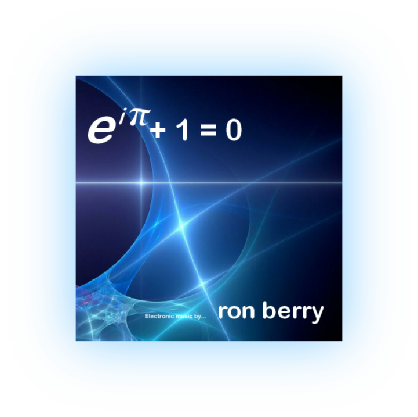About the Music...
A maths equation for the title? Well why not, it’s been done before? This one however is not so well known. It’s the work of 18th Century Swiss physicist and mathematician Leonhard Euler and describes the mysterious rather beautiful relationship between 5 special numbers of widely differing types including one imaginary one!. So you could say it’s a real magical formula. Scientists the world over marvel at his achievement and a learned maths magazine voted it the most beautiful formula ever. It struck me, as an electronic engineer, that all 5 numbers are also deeply embedded in the theory and practice of the electronics that are used to make electronic music. Intrigued? There is a short simple explanatory guide in basic school-standard maths to the equation, symbol meanings and numbers here... Euler’s equation. If you prefer, just refer to this album as “Euler”
The music is just two long tracks. Track 1 is virtually all created from just one sine wave based modular synthesiser patch and track 2 from an extension of it (see the technical section below). The aim was to create a rich soundscape album full of unusual and rich synthesiser sounds that would be constantly changing, evolving and hopefully engaging. The track titles, by the way, are extracts from titles of papers on electromagnetism published by the Scottish scientist James Clerk Maxwell (1831-1870). His groundbreaking work opened up the whole electronic age we all live in today. Like Leonhard Euler, Maxwell and so many other world changing scientists, sadly they go largely unnoticed by the media and general public. This is my humble tribute to them.
Technical stuff...
In the early days of synthesisers there were different philosophies on the use of these new instruments. Of the two major pioneers Bob Moog was happy to make his big modular systems with keyboards, Don Buchla thought keyboard use was hampering creativity and freedom to explore the true potential of this new and exciting instrument. So his modular systems came without one.
Buchla’s alternative philosophy, which I’ve made good use of in this album, features a patch I developed employing a simple 8 position 3 column analogue sequencer for pitches controlling some sine oscillators. Some were in traditional amplitude and/or frequency modulation configurations while filtering and further sound processing with sound delay modules added extra richness and interest to the sounds. The interaction between playing the varying sequencer speed settings the delays and all other settings, to my ears, produced some very immediate and interesting decaying rhythmic patterns, unusual timbre changes and odd effects. It’s quite surprising how rich and unusual a changing sound palette can be created using combinations of sine waves plus some simple techniques on a modular synthesiser.
The Euler link? Sine waves are basically trigonometric functions. Attacking and decaying volume envelope generators used are exponential as are decaying echoes which in theory decrease to infinity over an infinite time. Electronic engineers use imaginary numbers to help calculate many things like filter design problems of phase etc. A modular synthesiser is really just a maths based analogue computer after all. Finally recording was by digital electronics which converts the signals to 1’s and 0’s hence my appreciation of Euler’s amazing formula.
CD 015 tracks :-
1). “Treatise”
2). “Lines of Force”
1). “Treatise”
2). “Lines of Force”
CD Price £12
Download Price £8
Please read terms and conditions first!

Download album from here on receiving purchased pass codes.
27min 35secs MP3 excerpt 1, excerpt 2, excerpt 3 (128Kbit/s) 26min 32secs MP3 excerpt 1, excerpt 2, excerpt 3 (128Kbit/s)

| < Prev. Album | Album Sales | Ordering information | Home | Next Album> |